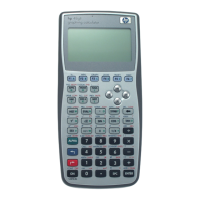
 Loading...
Loading...
Do you have a question about the HP 48GII and is the answer not in the manual?
| Battery type | CR2032 |
|---|---|
| Type | Scientific |
| Form factor |
| Weight | 220 g |
|---|---|
| Dimensions (WxDxH) | 184 x 87 x 23.5 mm |
Programs as objects, delimiters, and basic structure.
Details on how to create, store, and run programs.
Covers IF, CASE, IFT, IFTE structures for program decision-making.
Details commands like PROMPT, INPUT, INFORM, CHOOSE for user interaction.
Demonstrates recursive and loop-based Fibonacci calculations.
Details finding min/max elements using MNX and MNX2.
Explains the APLY command for transforming array elements.
Explains key presses and menu paths to access commands.
Details the absolute value function and its array behavior.
Explains the inverse cosine function, domain, and range.
Overview of CAS operations and their categorization by menu.
Lists and describes commands for algebraic manipulation.
Covers derivation, integration, and limit commands.
Provides equations for structural mechanics.
Lists equations related to electrical circuits and laws.
Covers equations for fluid mechanics.
Explains the purpose and usage of the development library.
Details APEEK, PEEK, POKE, POKEARM commands.
Discusses syntax, modes, and directives for MASD.
Alphabetical list of error messages.
Numerical list of error messages by hex code.
Description of various system flags.
Continuation of system flags description.
Explanation of key reserved variables.
Details plotting parameters.
Lists object sizes in bytes.
Provides a table of symbolic integration patterns.
Explains conditions for parallel list processing.
Describes how ADD and + handle parallel list operations.
Lists functions performed by key combinations.
Explains shift key effects on menu labels.
Menu numbers and paths for built-in menus.
Details commands available in Library 222.